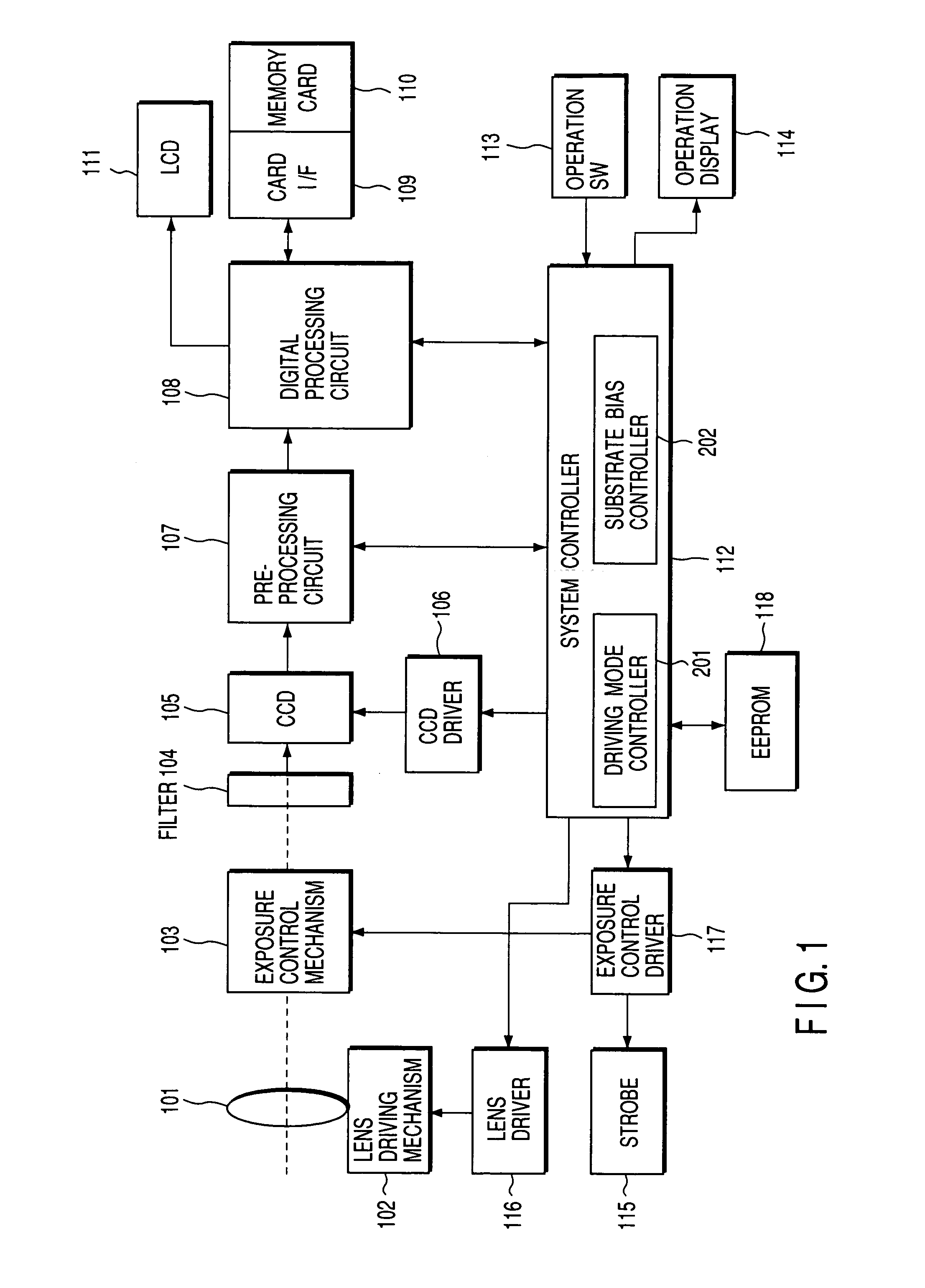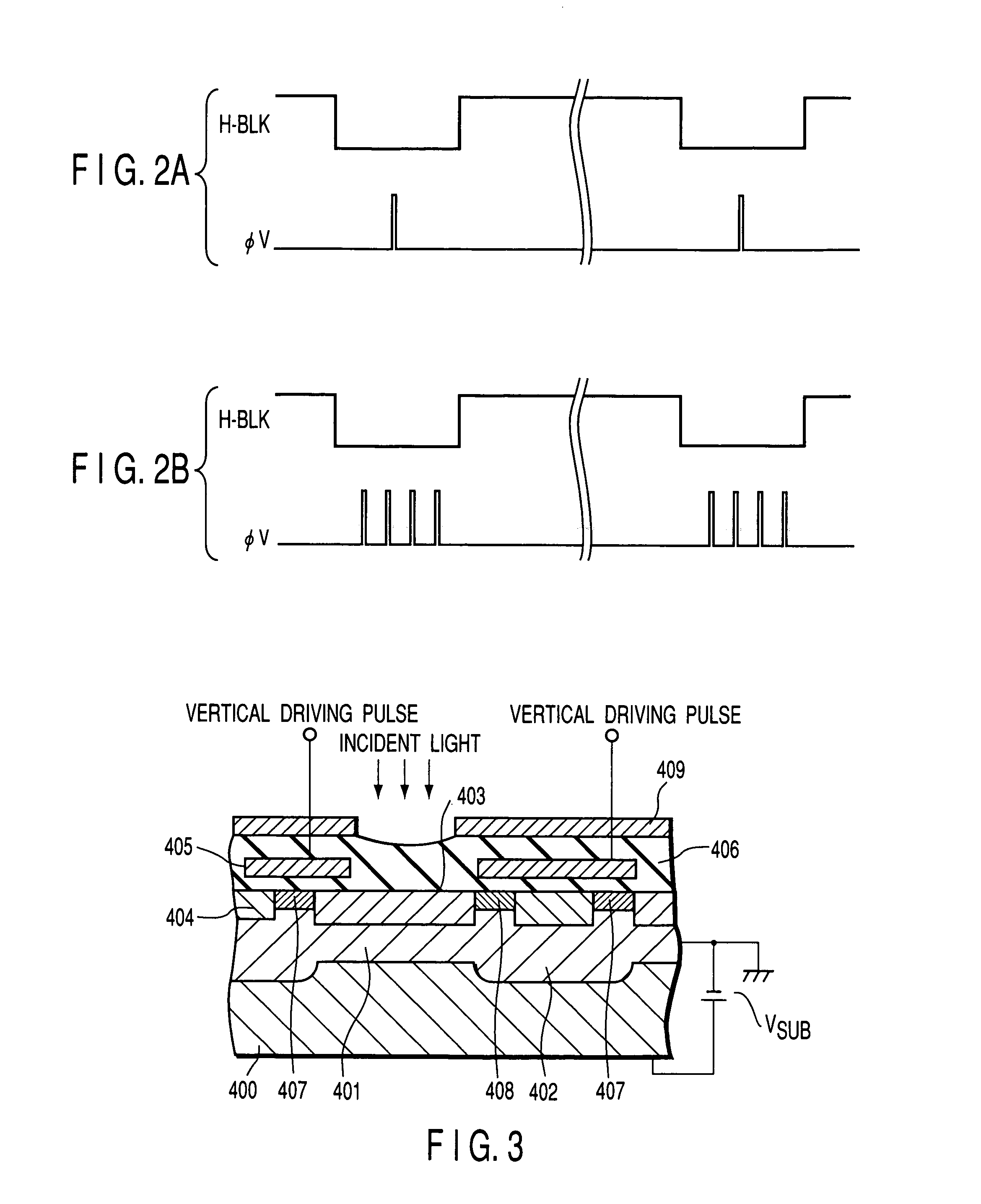Image pickup device capable of adjusting the overflow level of the sensor based on the read out mode
a pickup device and sensor technology, applied in the field of image pickup devices, can solve the problems of deteriorating picture quality, finite saturated level, horizontal streak noise along the horizontal line,
- Summary
- Abstract
- Description
- Claims
- Application Information
AI Technical Summary
Benefits of technology
Problems solved by technology
Method used
Image
Examples
first embodiment
[0031]FIG. 1 is a block diagram showing the first embodiment of the present invention. Light passed through a lens system 101 passes through an exposure control mechanism 103 (the stop of the lens system 101) and an optical filter 104 for cutting out high-frequency components and infrared components and is projected (or focused) on to a CCD 105. The CCD 105 has a color filter where a plurality of color components are arranged in a mosaic, pixel by pixel, at the image forming surface of the CCD. The output of the CCD 105 is inputted via a preprocessing circuit 107 including an A / D converter to a digital processing circuit 108 for carrying out a color signal generating process, a matrix conversion process, and various other digital processes. The color signal generated by the digital processing circuit 108 is displayed on an LCD display unit 111, acting as a viewfinder. A card interface 109 stores the color signal in a memory card 110 incorporating a nonvolatile memory which is a stor...
second embodiment
[0068]When the substrate bias voltage VSUB is varied, the color balance in the n-addition mode may differ from that in the non-addition mode. The sensitivity characteristic of the charge accumulating portion depends on the substrate bias voltage VSUB. Since the dependence is greater on the long wavelength side, the spectral characteristic also depends on the substrate bias voltage VSUB. This means that the R, G, B relative sensitivity of the CCD varies.
[0069]FIG. 8, where the value on the abscissa is wavelength in nm, shows a spectral sensitivity characteristic of the non-addition mode (solid line) and n-addition mode (broken line). In the spectral characteristic, B increases and R decreases in the n-addition mode (when the substrate bias voltage VSUB is raised), with G as a reference.
[0070]Traditionally, although the substrate bias voltage VSUB is subjected to fine adjustment in the camera manufacturing process, it is used almost in a fixed manner after the fine adjustment. In this...
third embodiment
[0087]In the second embodiment, the spectral characteristic is corrected on the basis of the variation characteristic of the spectral sensitivity with respect to a change in the substrate bias voltage shown in FIG. 10. FIG. 10 shows the relative magnitude of the B and R signals in the form of spectral sensitivity, using G as a reference (G=100 invariable). Therefore, when the absolute sensitivity (luminance sensitivity) is invariable in the n-addition driving with regards to the non-addition driving, the second embodiment applies to n-addition driving as it is. Actually, however, not only spectral sensitivity characteristics but also absolute sensitivity characteristics in n-addition driving may differ from those in non-addition driving. Hereinafter, a third embodiment of the present invention coping with such a change in the absolute sensitivity will be explained. Since the block diagram showing the configuration of the device is the same as that of FIG. 9, it will be omitted.
[0088...
PUM
 Login to View More
Login to View More Abstract
Description
Claims
Application Information
 Login to View More
Login to View More - R&D
- Intellectual Property
- Life Sciences
- Materials
- Tech Scout
- Unparalleled Data Quality
- Higher Quality Content
- 60% Fewer Hallucinations
Browse by: Latest US Patents, China's latest patents, Technical Efficacy Thesaurus, Application Domain, Technology Topic, Popular Technical Reports.
© 2025 PatSnap. All rights reserved.Legal|Privacy policy|Modern Slavery Act Transparency Statement|Sitemap|About US| Contact US: help@patsnap.com



